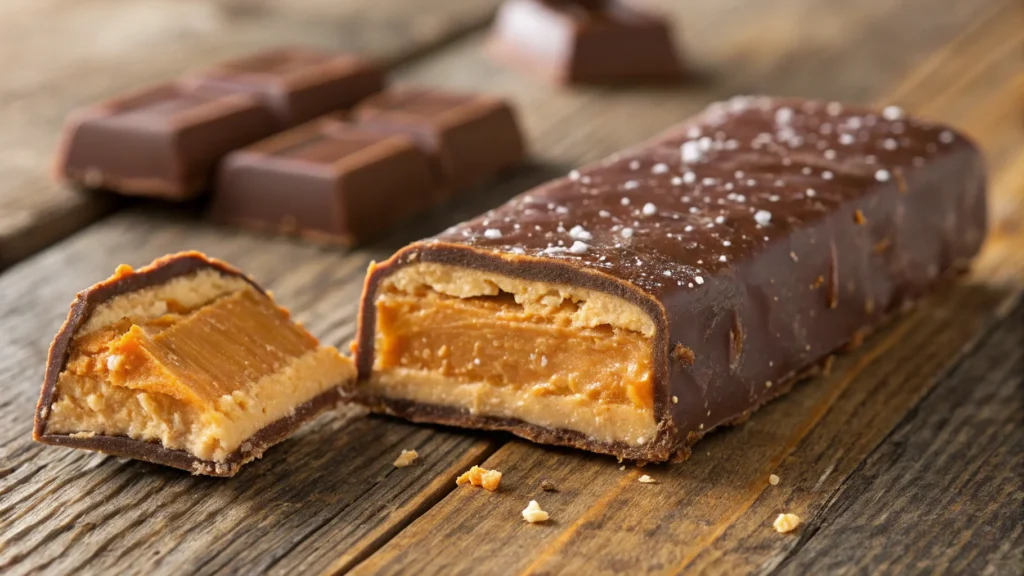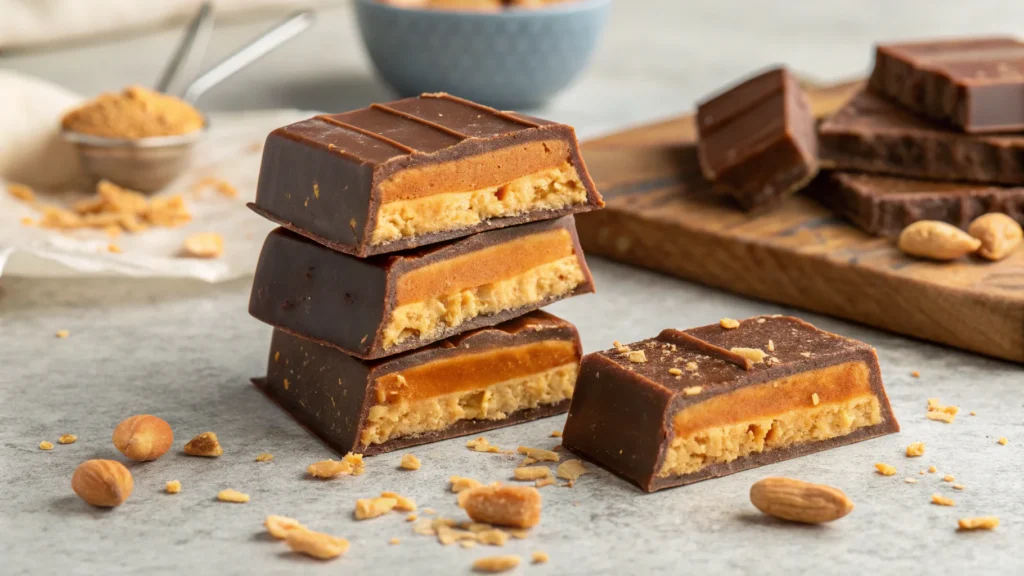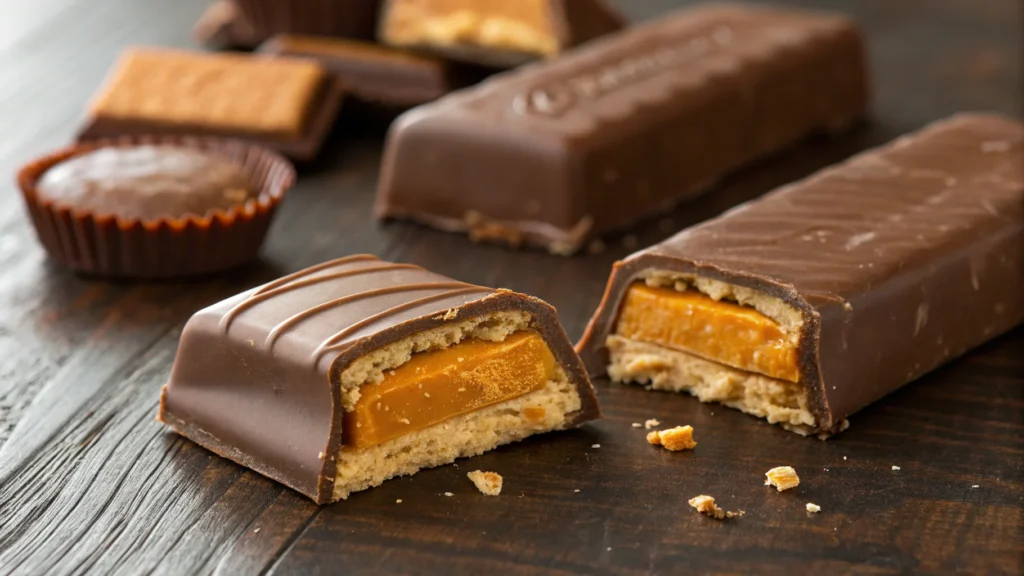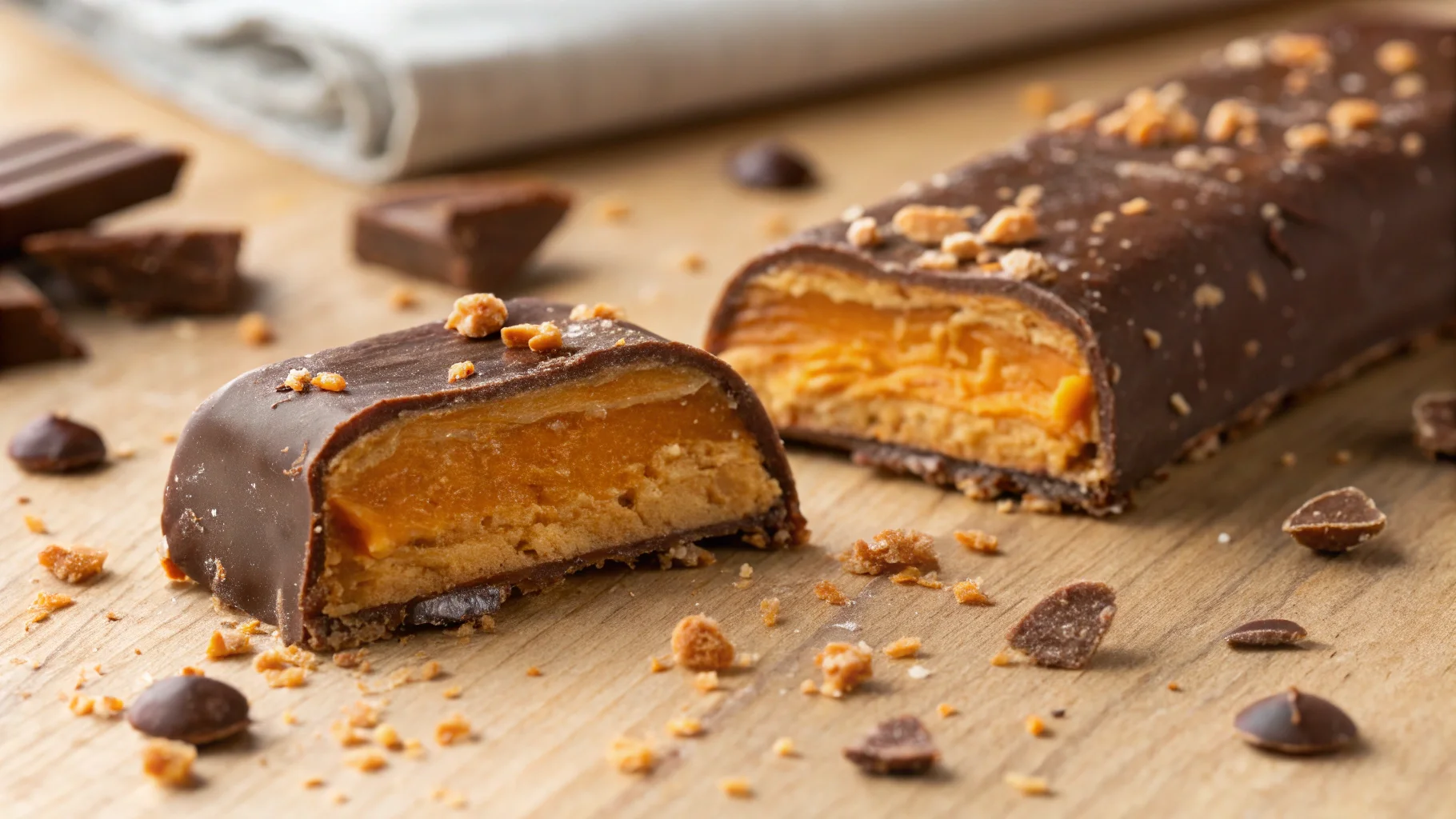Butterfinger is a classic candy bar with a crispy, flaky, peanut-buttery filling wrapped in smooth chocolate. But have you ever wondered what the orange stuff inside Butterfingers is? That unique texture and bright color make this candy stand out from other chocolate bars.
In this article, we’ll explore:
– What the orange filling is made of
– How its crispy, flaky layers are created
– Why Butterfingers taste so different from regular peanut butter candies
Let’s uncover the delicious secret behind Butterfinger’s famous filling!
Table of contents
- What Ingredients Make Up the Orange Stuff in Butterfingers?
- What Is the Orange Filling in Butterfingers Officially Named?
- Why Does the Orange Stuff in Butterfingers Crumble So Easily?
- How the Orange Stuff in Butterfingers Gets Its Signature Crunch
- How the Orange Stuff in Butterfingers Gets Its Signature Crunch
- Did the Orange Stuff in Butterfingers Change Over the Years?
- Surprising History and Trivia About Butterfingers’ Orange Filling
- FAQs – Answering Common Questions About the Orange Stuff in Butterfingers
- Conclusion: Why Butterfinger’s Orange staff Is So Unique
What Ingredients Make Up the Orange Stuff in Butterfingers?
The orange stuff in Butterfingers is a crispy, flaky peanut butter-flavored candy made primarily from corn syrup, sugar, and roasted peanuts. Unlike smooth peanut butter, this filling has thin, crunchy layers that create a unique bite and texture.
Why Is It Orange?
The bright orange color comes from:
– Caramelized sugar and molasses – When heated, these ingredients develop a golden-orange hue.
– Food coloring – A small amount of coloring is added to enhance the appearance.
What Makes It Crispy?
Instead of being creamy, the filling is brittle and flaky due to a special pulling and layering technique used during production. This process gives Butterfingers their signature crunchy texture that shatters when you bite into it.
Want to know how this filling is made? Keep reading in the next part!
What Is the Orange Filling in Butterfingers Officially Named?
The crispy filling inside a Butterfinger is officially called peanut butter brittle or flaky peanut candy. Unlike smooth peanut butter, which is creamy and spreadable, Butterfinger’s filling has a crunchy, layered structure that crumbles and melts in your mouth.
This unique texture is what makes Butterfinger different from other peanut butter candies like Reese’s or Snickers. Instead of a soft peanut butter center, Butterfinger’s filling is light, crisp, and full of peanut-buttery goodness.
The Difference Between Butterfinger Filling and Regular Peanut Butter
Many people mistakenly believe the orange filling in Butterfingers is just hardened peanut butter, but it’s actually quite different. Let’s compare:
| Feature | Butterfinger Filling | Regular Peanut Butter |
|---|---|---|
| Texture | Crispy, flaky, and crunchy | Smooth and creamy |
| Main Ingredients | Sugar, corn syrup, roasted peanuts | Roasted peanuts, oil, salt |
| Production Method | Cooked, layered, and cooled | Ground and mixed |
| Sweetness | High (contains sugar and molasses) | Low (only contains peanuts and salt) |
Instead of just grinding peanuts into a spreadable paste, candy makers heat and stretch a peanut-butter-infused sugar syrup to create Butterfinger’s filling. This creates thin layers of crispy candy that form the signature orange interior.
What Gives Butterfinger Its Unique Crunch?
The crunchy and brittle texture inside Butterfingers comes from a combination of ingredients and production techniques:
– Caramelized Sugar – Heating sugar causes it to crystallize, creating a crisp texture.
– Corn Syrup – Adds sweetness and keeps the candy from becoming too hard.
– Roasted Peanuts – Provide flavor and a nutty crunch.
– Molasses – Enhances the depth of flavor and contributes to the orange color.
– Air Pockets – Formed during the stretching process, giving the filling a light, flaky structure.
This method ensures that Butterfinger snaps apart easily when bitten while maintaining its signature melt-in-your-mouth finish.
A Closer Look at the Ingredients in Butterfinger’s Filling
Each ingredient in Butterfinger’s filling plays a key role in its texture, color, and taste:
| Ingredient | Purpose |
|---|---|
| Corn Syrup | Adds sweetness and prevents crystallization. |
| Sugar | Creates the crunchy structure when caramelized. |
| Roasted Peanuts | Adds a rich, nutty taste. |
| Molasses | Deepens the flavor and enhances the golden-orange hue. |
| Salt | Balances out the sweetness. |
| Food Coloring | Gives the filling its signature orange shade. |
Together, these ingredients create the irresistible crispy peanut butter taste that has made Butterfinger a fan-favorite for decades.
Want to explore more peanut butter-based candies? Check out this list of crunchy treats at Recipesolly.com!

Why Does the Orange Stuff in Butterfingers Crumble So Easily?
The flaky layers inside a Butterfinger are made through a unique cooking and layering process that combines sugar, corn syrup, and roasted peanuts. This technique results in thin, crispy sheets of candy that break apart easily when you bite into them.
Unlike regular peanut butter, which is thick and creamy, Butterfinger’s filling has a delicate, airy texture created by stretching and folding the hot candy mixture multiple times before cooling.
How Are the Flaky Layers Formed?
The secret to Butterfinger’s unique flaky texture lies in its manufacturing process. Here’s how it works:
- Cooking the Sugar Base – Candy makers heat a mixture of corn syrup, sugar, and molasses to a high temperature, causing the sugar to caramelize and develop a rich, golden color.
- Adding Ground Peanuts – Roasted peanuts are finely ground and mixed into the hot syrup, creating a deep, nutty flavor that blends smoothly with the caramelized sugar.
- Pulling and Layering – While still warm, the candy is pulled and stretched multiple times, much like taffy. This process traps air between the layers, forming the delicate, flaky texture that Butterfinger is known for.
- Cooling & Hardening – The stretched candy cools and solidifies, turning into a brittle, crunchy structure that will later be cut into bar shapes.
- Cutting & Chocolate Coating – Once hardened, the crispy peanut butter candy is cut into bars and coated in smooth milk chocolate, completing the Butterfinger’s signature look and taste.
Why Does Butterfinger’s Filling Snap Instead of Melt?
Most peanut butter candies have a soft, creamy consistency, but Butterfinger’s filling is designed to crumble and shatter when bitten. Here’s why:
– Sugar is cooked at a high temperature, making it brittle rather than chewy.
– Air pockets form between the layers, reducing density and making it easier to snap.
– Moisture content is low, preventing it from becoming sticky or gooey.
This process sets Butterfinger apart from other peanut butter-based candies, giving it a crispy, delicate crunch that melts in your mouth.
The Science Behind Butterfinger’s Crunch
The crispy layers inside Butterfingers are a result of sugar crystallization. When sugar is heated and then cooled quickly, it forms tiny sugar crystals that create a light, flaky texture.
– The more the candy is stretched and folded, the crispier the texture becomes.
– Trapped air pockets make the candy less dense and more brittle.
This is what gives Butterfinger its signature light, crunchy, and flaky consistency, making it one of the most unique candy bars on the market.
Curious about other candies with unique textures? Discover more crispy, flaky treats at Recipesolly.com!
How the Orange Stuff in Butterfingers Gets Its Signature Crunch
Butterfinger’s crispy, flaky peanut butter filling isn’t just ground peanuts—it’s a carefully crafted peanut butter brittle. Candy makers use a precise process of cooking, stretching, and layering to create its light, crunchy texture, making it stand out from other peanut butter candies.
Step-by-Step Process of Making Butterfinger Filling
Butterfinger’s crispy interior comes from a precise process of mixing, cooking, and cooling the ingredients. Here’s a step-by-step breakdown:
1. Heating the Sugar Mixture
- The base of the filling starts with a mixture of corn syrup, sugar, and molasses.
- This mixture is heated to a high temperature (about 300°F or 149°C), allowing the sugar to caramelize.
- Cooking the sugar to this temperature creates a brittle, crunchy structure instead of a soft, chewy one.
2. Adding Peanut Butter
- Unlike traditional peanut butter, which is ground into a smooth paste, Butterfinger uses a special roasted peanut mixture.
- This peanut mixture is added to the hot sugar syrup and stirred quickly to evenly distribute the flavor.
- The heat slightly toasts the peanut flavor, intensifying its taste.
3. The Pulling and Folding Process
- While the mixture is still warm, it is stretched and folded repeatedly, similar to how taffy or croissant dough is made.
- This traps tiny air pockets between the layers, creating the signature flaky and crispy texture.
- The more it’s pulled and folded, the lighter and crunchier the final product becomes.
4. Cooling and Hardening
- The stretched peanut butter mixture is left to cool at room temperature, allowing it to harden into thin, brittle sheets.
- This is what makes Butterfinger snap apart when you bite into it, instead of being chewy like a Snickers or Reese’s.
5. Cutting and Chocolate Coating
- The cooled peanut butter brittle is cut into bar shapes.
- Each piece is then coated in smooth milk chocolate, creating the final Butterfinger bar that we all know and love.
Why Does Butterfinger’s Filling Crumble Instead of Melt?
Unlike regular peanut butter, which has oils that make it smooth and spreadable, Butterfinger’s filling is low in moisture and high in sugar. This is why it snaps apart into crispy shards instead of melting in your mouth like peanut butter.
| Characteristic | Butterfinger Filling | Regular Peanut Butter |
|---|---|---|
| Texture | Crisp, flaky, and brittle | Smooth and creamy |
| Moisture Content | Low (hardened sugar base) | High (natural peanut oils) |
| Melting Point | Doesn’t melt easily | Softens at room temperature |
This unique composition is what makes Butterfinger so distinct from other peanut butter candies!

How the Orange Stuff in Butterfingers Gets Its Signature Crunch
Many peanut butter candies are soft and creamy, so what makes Butterfinger so light, crisp, and crunchy?
The answer lies in a combination of ingredients and the cooking process, which create the brittle, flaky layers inside each bar.
The Secret Behind Butterfinger’s Crunchy Texture
1. Sugar Cooking Process
- Candy makers heat Butterfinger’s sugar base to a high temperature (around 300°F).
- This allows the sugar to caramelize and crystallize, forming a crisp, brittle structure instead of a chewy or gooey consistency.
- The result? A delicate texture that shatters when you bite into it.
2. Low Moisture Content
- Unlike peanut butter, which contains natural oils and moisture, Butterfinger’s filling is almost completely dry.
- This prevents it from becoming sticky or soft and helps it maintain its light, airy crunch.
3. The Pulling and Folding Technique
- As mentioned earlier, the pulling and layering process creates thin sheets of crispy peanut butter candy.
- This technique works like folding pastry dough to create flaky layers, but here, candy makers use a peanut butter-infused sugar mixture. The more they stretch it, the crunchier the texture becomes
4. Air Pockets Inside the Filling
- The stretching process traps tiny air pockets between the layers.
- These air pockets give Butterfinger its light, crispy texture, making it less dense than other peanut butter-based candies.
- This is why Butterfinger breaks apart so easily and feels lighter than a peanut butter cup.
Comparison: Butterfinger vs. Other Peanut Butter Candies
| Candy | Texture |
|---|---|
| Butterfinger | Crispy, flaky, and brittle |
| Reese’s Cups | Soft, creamy peanut butter filling |
| Snickers | Chewy caramel and peanut nougat |
| PayDay | Firm, nutty caramel coating |
Butterfinger’s crisp, flaky filling is completely unique, making it one of the most recognizable candy bars on the market.
Final Thoughts on Butterfinger’s Unique Texture
Butterfinger’s crispy, flaky filling is the result of precise sugar cooking, stretching, and cooling techniques. The combination of:
– Caramelized sugar for crispness
– Ground roasted peanuts for flavor
– A unique layering process for texture
– Low moisture content for a delicate crunch
…is what makes Butterfinger stand out from other peanut butter candies.
Looking for more crispy peanut butter treats? Check out this list of unique peanut-based desserts at Recipesolly.com!
Did the Orange Stuff in Butterfingers Change Over the Years?
Yes, the orange filling in Butterfingers has changed over time, with subtle adjustments to its texture, flavor, and ingredients. While the candy bar has always maintained its crispy, flaky peanut butter filling, modifications in the recipe have made a noticeable difference for longtime fans.
1. Has the Texture of the Orange Filling Changed?
Many people recall the original Butterfinger filling as being extra crumbly, almost breaking apart into delicate shards with each bite. In recent years, the texture has become slightly firmer, making it less likely to crumble immediately but still maintaining its signature crispiness.
2. Is the Orange Stuff in Butterfingers Less Sweet Now?
Over time, the balance of sweetness and peanut flavor has been fine-tuned. Some candy lovers have noticed that the current version has a stronger roasted peanut taste, whereas earlier versions had a sweeter, more caramel-like flavor. This adjustment has made the filling taste more peanut-forward, allowing the nutty notes to stand out.
3. Did the Chocolate Coating Affect the Filling?
Although the chocolate layer mainly affects the outer taste, changes in its composition and thickness can alter how the crispy filling feels and tastes. A slightly smoother chocolate layer can change the way the bar breaks apart in the mouth, affecting the overall texture experience.
4. Has the Color of the Orange Stuff in Butterfingers Changed?
The bright orange color has remained a signature feature, but slight refinements in the ingredient mix might have enhanced the golden hue over time. The deep caramelization of sugars and the balance of natural coloring give the filling its distinct appearance, which remains consistent with the classic look of the bar.
5. Why Do Some People Notice a Difference?
Changes in ingredient sourcing, production techniques, and consumer preferences over the years may explain why some people feel that the orange stuff in Butterfingers isn’t quite the same as they remember. Slight alterations can lead to:
– A less crumbly but still flaky texture
– A more pronounced peanut flavor
– A different balance between sweetness and nuttiness
Despite these refinements, the crispy, peanut-buttery essence of Butterfinger’s filling remains a key part of what makes it so iconic.
Curious about other unique candy textures? Check out this list of crispy peanut butter treats at Recipesolly.com!
Surprising History and Trivia About Butterfingers’ Orange Filling
Beyond its crispy texture and peanut butter flavor, Butterfinger has a fascinating history filled with fun trivia, marketing stunts, and celebrity endorsements. Here are some of the most interesting facts about Butterfinger!
1. The Name “Butterfinger” Came from a Public Contest
When the Curtiss Candy Company created Butterfinger in 1923, they held a public naming contest. The name ‘Butterfinger’ came from a slang term for someone who frequently drops things, a phrase commonly used in sports.
2. Butterfinger Bars Were Once Dropped from Airplanes
In the 1920s, Butterfinger (and Baby Ruth) bars were part of a massive marketing stunt where the Curtiss Candy Company dropped thousands of candy bars from airplanes over U.S. cities to promote the brand. This was one of the first viral marketing campaigns in history!
3. Bart Simpson Was the Face of Butterfinger Ads for Years
In the 1990s and early 2000s, Butterfinger had one of the most famous candy advertisements of all time, featuring Bart Simpson from The Simpsons.
– The catchphrase “Nobody better lay a finger on my Butterfinger!” became one of the most well-known candy slogans.
– The partnership lasted more than 20 years, making it one of the longest-running celebrity endorsements in candy history.
4. Butterfinger Once Released a Limited-Edition Flavor
In 2009, Butterfinger introduced Butterfinger Buzz, a limited-edition version that contained 80 milligrams of caffeine per bar—about the same as a cup of coffee!
– This version was marketed as an “energy candy bar”, but it was discontinued after a short run.
5. Butterfinger Has a Baked Version Called “Butterfinger Baking Bits”
Did you know that Butterfinger makes pre-crushed Butterfinger pieces designed for baking?
– They are perfect for cookies, brownies, and cheesecakes, giving desserts a delicious peanut butter crunch.
– You can find these Butterfinger Baking Bits in most grocery stores in the baking aisle.
Looking for ways to use Butterfinger in recipes? Check out some delicious Butterfinger dessert ideas at Recipesolly.com!
6. Butterfinger Used to Have a Peanut Butter Cup Version
In 2014, Butterfinger launched Butterfinger Peanut Butter Cups, a competitor to Reese’s. Unlike Reese’s, these cups had a crispy, flaky texture inside, giving them a unique crunch.
– Unfortunately, they were discontinued a few years later, but they still have a loyal fan following!
7. Butterfinger Was Temporarily Discontinued in Germany
In the early 2000s, Butterfinger was removed from German stores due to concerns about a food additive that was banned in the country at the time.
– However, the candy bar eventually returned to shelves in Germany after reformulations were made.
Final Thoughts on Butterfinger’s Fun Fact
Butterfinger has been around for over 100 years, and its crispy, peanut butter filling continues to make it one of the most popular candy bars in the U.S. and beyond. From its airplane marketing stunt to its iconic Bart Simpson ads, Butterfinger has a legacy that’s as bold as its taste.
Whether you love the classic version or the new Ferrero recipe, one thing remains true—Butterfinger’s unique crispy peanut butter filling is unlike anything else on the market!
Want more Butterfinger history and fun candy facts? Explore candy trivia and more at Recipesolly.com!

FAQs – Answering Common Questions About the Orange Stuff in Butterfingers
Over the years, Butterfinger has sparked a lot of curiosity, especially about its crispy, orange filling. Here, we answer the most frequently asked questions about this beloved candy bar!
1. What is the orange stuff in Butterfingers made of?
The orange filling inside Butterfingers is a crispy peanut butter-flavored candy made from:
– Corn syrup and sugar – Caramelized to create a crunchy texture.
– Roasted peanuts – Blended into the candy for a peanut butter taste.
– Molasses – Adds a deep, rich flavor and contributes to the golden-orange color.
– Salt – Enhances the overall flavor and balances sweetness.
– Food coloring – Gives the filling its signature bright orange shade.
Unlike regular peanut butter, which is smooth and creamy, Butterfinger’s filling is crispy and flaky due to a unique layering and pulling process.
2. Is Butterfinger filling just peanut butter?
No! Butterfinger’s filling is not regular peanut butter. Instead, it’s a peanut butter brittle mixture, meaning the peanut butter is combined with sugar and corn syrup, then cooked and stretched to create light, flaky layers. This is what makes Butterfinger’s filling crispy and crunchy instead of creamy.
3. What is the flaky stuff in Butterfingers?
The flaky layers inside Butterfinger come from a pulling and folding process during manufacturing.
– The peanut butter mixture is stretched and folded multiple times.
– This creates thin, airy layers that break apart when bitten.
– The low moisture content keeps the filling light and crisp, rather than chewy or gooey.
4. What is the hard stuff in Butterfingers?
The hard texture of Butterfinger’s filling comes from sugar crystallization.
– The sugar and corn syrup are cooked at a high temperature.
– When cooled, the mixture hardens into a brittle, crispy candy.
– This is what makes Butterfinger shatter into crunchy flakes when you bite into it!
5. Is Butterfinger gluten-free?
No, Butterfinger is not gluten-free because it contains barley malt extract, which has gluten. If you’re looking for a gluten-free peanut butter candy, you may need to find an alternative.
6. Does Butterfinger contain real chocolate?
Yes! Butterfinger is coated in real milk chocolate. However, the chocolate in the new Ferrero recipe is now smoother and creamier compared to the older version.
7. Can you make Butterfinger filling at home?
Yes! While the official recipe is a secret, you can make homemade Butterfinger bars using just a few ingredients:
– Corn syrup & sugar – To create the crunchy base.
– Peanut butter – For the nutty flavor.
– Crushed cornflakes – To mimic the crispy texture.
– Chocolate – To coat the candy bars.
If you want to try making your own homemade Butterfinger-style treats, check out this easy recipe at Recipesolly.com!
8. Are Butterfingers vegetarian?
Yes, Butterfinger is vegetarian-friendly because it does not contain gelatin or animal-derived enzymes. However, it is not vegan because it contains milk-based ingredients in the chocolate coating.
Conclusion: Why Butterfinger’s Orange staff Is So Unique
The orange, flaky filling inside Butterfinger is one of the most unique candy textures in the world. Instead of being soft and creamy like most peanut butter treats, Butterfinger has a crispy, crunchy texture that shatters when you bite into it.
Key Takeaways
– The orange color comes from caramelized sugar, molasses, and food coloring.
– It’s made with roasted peanuts, but it’s not regular peanut butter.
– A special layering and pulling technique creates the crispy, flaky texture.
– Butterfinger is coated in real milk chocolate and is vegetarian-friendly.
Despite recipe changes over the years, Butterfinger remains one of the most beloved peanut butter chocolate bars on the market. Whether you prefer the classic version or the new recipe, one thing is certain—nobody better lay a finger on your Butterfinger!
Want to learn more about candy ingredients? Read this detailed guide on what is the orange stuff in Butterfingers at Recipesolly.com!

